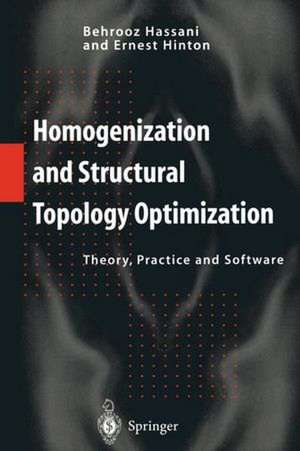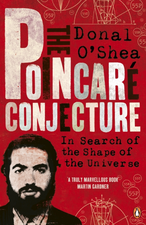Homogenization and Structural Topology Optimization: Theory, Practice and Software
Autor Behrooz Hassani, Ernest Hintonen Limba Engleză Paperback – 28 oct 2011
Preț: 891.62 lei
Preț vechi: 1087.34 lei
-18% Nou
Puncte Express: 1337
Preț estimativ în valută:
170.67€ • 185.44$ • 143.45£
170.67€ • 185.44$ • 143.45£
Carte tipărită la comandă
Livrare economică 21 aprilie-05 mai
Preluare comenzi: 021 569.72.76
Specificații
ISBN-13: 9781447112297
ISBN-10: 1447112296
Pagini: 300
Ilustrații: XXV, 268 p.
Dimensiuni: 155 x 235 x 20 mm
Greutate: 0.46 kg
Ediția:Softcover reprint of the original 1st ed. 1999
Editura: SPRINGER LONDON
Colecția Springer
Locul publicării:London, United Kingdom
ISBN-10: 1447112296
Pagini: 300
Ilustrații: XXV, 268 p.
Dimensiuni: 155 x 235 x 20 mm
Greutate: 0.46 kg
Ediția:Softcover reprint of the original 1st ed. 1999
Editura: SPRINGER LONDON
Colecția Springer
Locul publicării:London, United Kingdom
Public țintă
ResearchDescriere
Structural topology optimization is a fast growing field that is finding numerous applications in automotive, aerospace and mechanical design processes. Homogenization is a mathematical theory with applications in several engineering problems that are governed by partial differential equations with rapidly oscillating coefficients Homogenization and Structural Topology Optimization brings the two concepts together and successfully bridges the previously overlooked gap between the mathematical theory and the practical implementation of the homogenization method. The book is presented in a unique self-teaching style that includes numerous illustrative examples, figures and detailed explanations of concepts. The text is divided into three parts which maintains the book's reader-friendly appeal.
Cuprins
Preface vii.- Acknowledgements xi.- Table of Contents xiii.- Notation xvii.- 1. Introduction.- 1.1 Overview.- 1.2 Mathematical description of optimization problem.- 1.3 Types of structural optimization.- 1.4 Aspects of topology optimization.- 1.5 Layout of the book.- References.- I: Homogenization.- 2. Homogenization Theory for Media with a Periodic Structure.- 2.1 Introduction.- 2.2 Periodicity and asymptotic expansion.- 2.3 One dimensional elasticity problem.- 2.4 General boundary value problem.- 2.5 Elasticity problem in cellular bodies.- References.- 3. Solution of Homogenization Equations for Topology Optimization.- 3.1 Introduction.- 3.2 Material models.- 3.2.1 Rectangular microscale voids.- 3.2.2 Ranked layered material cells.- 3.2.3 Artificial materials.- 3.3 Analytical Solution of the homogenization equation for rank laminate composites.- 3.3.1 Rank-1 materials.- 3.3.2 Rank-2 materials.- 3.3.3 Bi-material rank-2 composites.- 3.4 Numerical Solution of the homogenization equation for a cellular body with rectangular holes.- 3.4.1 Finite element formulation.- 3.4.2 Derivation of the boundary conditions from periodicity.- 3.4.3 Examples.- 3.4.4 Homogenization constitutive matrix for Square microcells with rectangular voids.- 3.4.5 Least squares smoothing.- References.- II: Topology Optimization.- 4. Structural Topology Optimization using Optimality Critieria Methods.- 4.1 Introduction.- 4.2 Kuhn-Tucker condition.- 4.3 Analytical optimality criteria.- 4.3.1 An illustrative example of variational analysis.- 4.3.2 An illustrative example of derivation of optimality criteria.- 4.4 Mathematical model for the topological structural optimization.- 4.5 Optimality criteria for the topological structural optimization.- 4.5.1 Optimality conditions.- 4.5.2 Updating scheme.- 4.5.3 A modified resizing scheme.- 4.6 Optimal Orientation.- 4.7 Algorithm.- 4.8 Examples.- References.- 5. Experiences in Topology Optimization of Plane Stress Problems.- 5.1 Introduction.- 5.2 Effect of material model.- 5.2.1 Material model with rectangular holes.- 5.2.2 Artificial material model.- 5.2.3 Rank-2 material model.- 5.3 Effect of resizing scheme.- 5.4 Effect of the orientation variable.- 5.5 Effect of finite element discretization.- 5.5.1 Continuation method.- 5.5.2 Unstructured mesh.- 5.7 Effect of material volume.- 5.8 Effect of resizing parameters.- 5.9 Examples.- 5.9.1 Bridge with support layout 1.- 5.9.2 Bridge with support layout 2.- 5.9.3 Bracket with a hole.- 5.9.4 Shear wall with openings.- References.- 6. Topological layout and Reinforcement Optimization of Plate Structures.- 6.1 Introduction.- 6.2 Selection of plate base cell model.- 6.3 A brief review of Mindlin-Reissner plate theory.- 6.4 Homogenization of the plate model microstructure.- 6.5 Optimization problem.- 6.6 The finite element method.- 6.7 Optimal rotation.- 6.8 Examples.- 6.8.1 Simple supported Square plate with a central point load.- 6.8.2 Simple supported Square plate subject to a uniform load.- 6.8.3 Square plate subject to four point loads.- 6.8.4 Square slab with a circular holes.- 6.8.5 Fiat slab of a multi-span floor.- References.- III: Other Methods and Integrated Structural Optimization.- 7. Alternative Approaches to Structural Topology Optimization.- 7.1 Introduction.- 7.2 Simulation of functional adaptation of bone mineralization.- 7.2.1 A remodelling scheme based on effective strain energy density.- 7.2.2 A scheme based on effective stresses.- 7.3 Evolutionary fully stressed design method.- References.- 8. Integrated Structural Optimization.- 8.1 Introduction.- 8.2 Overview of integrated structural optimization.- 8.3 Topology optimization module.- 8.3.1 Ground structure method.- 8.3.2 Bubble method.- 8.4 Image processing module.- 8.4.1 Elimination of mesh dependency and checkerboard Problems using noise cleaning techniques.- 8.5 Shape optimization module.- 8.5.1 Boundary Variation method.- 8.5.2 Adaptive growth method.- 8.6 Integrated adaptive topology and shape optimization.- 8.7 Final thoughts.- References.- Appendix A.- Appendix B.- Appendix C.- Appendix D HOMOG Manual.- Appendix E PLATO Manual.- Author Index.
Caracteristici
Bridges the gap between the mathematical basis and the practical implementation of the homogenization method
Unique self-teaching method which is user-friendly
Free software to get the most out of the text
Unique self-teaching method which is user-friendly
Free software to get the most out of the text













